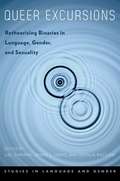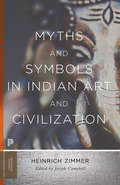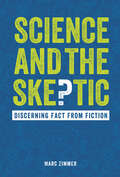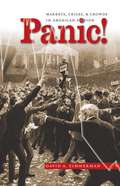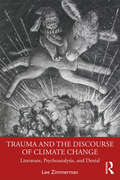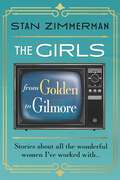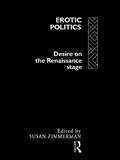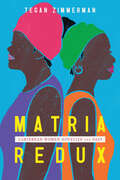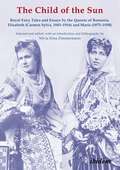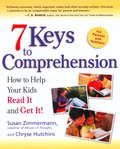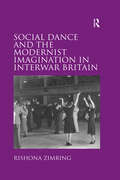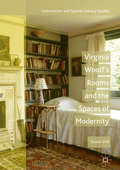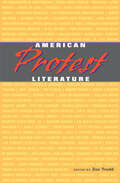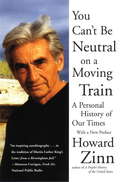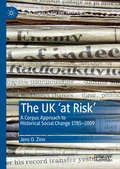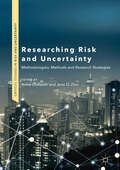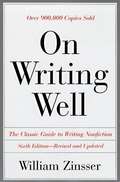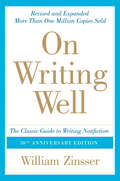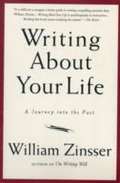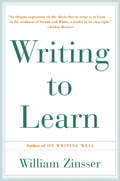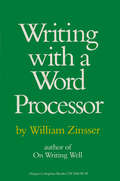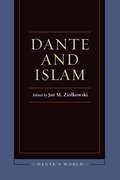- Table View
- List View
J. M. Coetzee and the Politics of Style
by Jarad ZimblerJ. M. Coetzee's early novels confronted readers with a brute reality stripped of human relation and a prose repeatedly described as spare, stark, intense and lyrical. In this book, Jarad Zimbler explores the emergence of a style forged in Coetzee's engagement with the complexities of South African culture and politics. Tracking the development of this style across Coetzee's first eight novels, from Dusklands to Disgrace, Zimbler compares Coetzee's writing with that of South African authors such as Gordimer, Brink and La Guma, whilst re-examining the nature of Coetzee's indebtedness to modernism and postmodernism. In each case, he follows the threads of Coetzee's own writings on stylistics and rhetoric in order to fix on those techniques of language and narrative used to activate a 'politics of style'. In so doing, Zimbler challenges long-held beliefs about Coetzee's oeuvre, and about the ways in which contemporary literatures of the world are to be read and understood.
Queer Excursions: Retheorizing binaries in Language, Gender, and Sexuality (Studies in Language and Gender, and Sexuality series)
by Lal Zimman Joshua Raclaw Jenny L. DavisThe chapters in Queer Excursions offer a series of distinct perspectives on these binaries, as well as on a number of other, less immediately apparent dichotomies that nevertheless permeate the gendered and sexual lives of speakers. Several chapters focus on the limiting or misleading qualities of bi-naristic analyses, while others suggest that binaries are a crucial component of social meaning within particular communities of study.
Myths and Symbols in Indian Art and Civilization (Princeton Classics #111)
by Heinrich Robert ZimmerA landmark work that demystifies the rich tradition of Indian art, Myths and Symbols in Indian Art and Civilization analyzes key motifs found in legend, myth, and folklore taken directly from the Sanskrit. It provides a comprehensive introduction to visual thinking and picture reading in Indian art and thought. Ultimately, the book shows that profound Hindu and Buddhist intuitions on the riddles of life and death are universally recognizable.
Science and the Skeptic: Discerning Fact from Fiction
by Marc ZimmerFake news, pseudoscience, and quackery have become scourges, spreading through society from social media all the way to Congress. The line between entertainment and reality, between fact and fiction, has become blurred. Some of the most crucial issues of our time—climate change, vaccines, and genetically modified organisms—have become prime targets for nefarious disinformation campaigns. Far too many people have become distrustful of real science. Even those who still trust science no longer know what to believe or how to identify the truth. Not only does this result in the devaluation and distrust of real science, but it is also dangerous: people acting based on false information can hurt themselves or those around them. We must equip ourselves with the knowledge and skills to fight back against all this disinformation. InScience and the Skeptic: Discerning Fact from Fiction, you will learn how science is done, from the basic scientific method to the vetting process that scientific papers must go through to become published; how and why some people intentionally or unintentionally spread misinformation; and the dangers in believing and spreading false information. You'll also find twenty easy-to-follow rules for distinguishing fake science from the real deal. Armed with this book, empower yourself with knowledge, learning what information to trust and what to dismiss as deceit. "We're not just fighting an epidemic; we're fighting an infodemic. . . . This is a time for facts, not fear. This is a time for rationality, not rumors. This is a time for solidarity, not stigma."—Tedros Adhanom Ghebreyesus, director-general of the WHO "Our deepest beliefs should help navigate reality, not determine it."—Michael Gersen, The Washington Post "Journalism is very much about trying to simplify and distribute information about what's new and where advances have been made. That's incompatible with the scientific process, which can take a long time to build a body of evidence."—Kelly McBride, Poynter Institute
Panic!
by David A. ZimmermanDuring the economic depression of the 1890s and the speculative frenzy of the following decade, Wall Street, high finance, and market crises assumed unprecedented visibility in the United States. Fiction writers published scores of novels in the period that explored this new cultural phenomenon. In Panic!, David A. Zimmerman studies how American novelists and their readers imagined--and in one case, incited--market crashes and financial panics. Panic! examines how Americans' attitudes toward securities markets, popular investment, and financial catastrophe were entangled with their conceptions of gender, class, crowds, corporations, and history. Zimmerman investigates how writers turned to mob psychology, psychic investigations, and conspiracy discourse to understand not only how financial markets worked, but also how mass acts of financial reading, including novel reading, could trigger economic disaster and cultural chaos. In addition, Zimmerman shows how, by concentrating on markets in crisis, novelists were able to explore the limits of fiction's aesthetic, economic, and ethical capacities. With readings of canonical as well as lesser-known novelists, Zimmerman provides an original and wide-ranging analysis of the relation between fiction and financial modernity.
Trauma and the Discourse of Climate Change: Literature, Psychoanalysis and Denial
by Lee ZimmermanThe more the global north has learned about the existential threat of climate change, the faster it has emitted greenhouse gases into the atmosphere. In Trauma and the Discourse of Climate Change, Lee Zimmerman thinks about why this is by examining how "climate change" has been discursively constructed, tracing how the ways we talk and write about climate change have worked to normalize a generalized, bipartisan denialism more profound than that of the overt "denialists." Suggesting that we understand that normalized denial as a form of cultural trauma, the book explores how the dominant ways of figuring knowledge about global warming disarticulate that knowledge from the trauma those figurations both represent and reproduce, and by which they remain inhabited and haunted. Its early chapters consider that process in representations of climate change across a range of disciplines and throughout the public sphere, including Al Gore’s An Inconvenient Truth, Barack Obama’s speeches and climate plans, and the 2015 Paris Agreement. Later chapters focus on how literary representations especially, for the most part, participate in such disarticulations, and to how, in grappling with the representational difficulties at the climate crisis’s heart, some works of fiction—among them Cormac McCarthy’s The Road and Russell Hoban’s Riddley Walker—work against that normalized rhetorical violence. The book closes with a meditation centered on the dream of the burning child Freud sketches in The Interpretation of Dreams. Highlighting the existential stakes of the ways we think and write about the climate, Trauma and the Discourse of Climate Change aims to offer an unfamiliar place from which to engage the astonishing quiescence of our ecocidal present. This book will be essential reading for academics and students of psychoanalysis, environmental humanities, trauma studies, literature, and environmental studies, as well as activists and others drawn to thinking about the climate crisis.
The Girls: From Golden to Gilmore
by Stan Zimmerman&“...the very definition of a page-turner. READ THIS BOOK!&” – Colin Mochrie, &“Whose Line is It Anyway?,&” &“Hyprov&”The Girls: From Golden to Gilmore is the story of Stan Zimmerman, a gawky Jewish boy who dreamed of becoming a wildly successful actor, rich enough to build his own mansion in the Hollywood Hills. While the actor part didn't quite pan out, Stan found success as a writer, producer, director, and playwright, working on such shows as The Golden Girls, Roseanne, and Gilmore Girls. Growing up in a small suburb of Detroit, Michigan, Stan was surrounded by three strong, intelligent women-his mother, his grandmother, and his sister-all of whom supported his imagination and creativity. Instead of playing outside, he spent time in his basement directing and acting in plays with the neighborhood kids. At seven-and-a-half years old, he was the youngest student accepted into a prestige summer theater school program. After high school, he was awarded a work/study scholarship to NY/Circle in the Square, where he met his first serious boyfriend and became Andy Warhol's unwitting photo subject one night at Studio 54. He also met Jim Berg, a journalism student at NYU's University Without Walls, forming a writing partnership that has continues to this day. partnership to this day. Their latest project is naturally an all-star, female ensemble Christmas comedy movie for Lifetime! Throughout his life, most of Stan's friendships have been with females. He credits those friendships and the women in his family with his ability to connect with creative women who have played a part in his career success. Accompanied by journal entries, The Girls details Stan's relationships with some of entertainment's most notable women, including Roseanne Barr, Lily Tomlin, Sandra Bernhard, Lauren Graham and Alexis Bledel, and, of course, all four Golden Girls. The Girls: From Golden to Gilmore is a candid, funny, and sometimes poignant testimony about how a young boy turned his dream into reality.
Erotic Politics: The Dynamics of Desire in the Renaissance Theatre
by Susan ZimmermanIdentifying the stage as a primary site for erotic display, these essays take eroticism in Renaissance culture as a paradigm for issues of sexuality and identity in early modern culture. Contributors examine how the Renaissance stage functioned as a decoder for erotic experience, both reinforcing and subverting expected sexual behaviour. They argue that the dynamics of theatrical eroticism served to deconstruct gender definitions, leaving conventional categories of sexuality blurred, confused - or absent. In seeking to reposition the conventions and subversions of gender and desire in terms of one another, these essays open up an attractive and distinctive perspective in cultural debate.
Matria Redux: Caribbean Women Novelize the Past (Caribbean Studies Series)
by Tegan ZimmermanIn Matria Redux: Caribbean Women Novelize the Past, author Tegan Zimmerman contends that there is a need for reading Caribbean women’s texts relationally. This comprehensive study argues that the writer’s turn to maternal histories constitutes the definitive feature of this transcultural and transnational genre. Through an array of Caribbean women’s historical novels published roughly between 1980 and 2010, this book formulates the theory of matria—an imagined maternal space and time—as a postcolonial-psychoanalytic feminist framework for reading fictions of maternal history written by and about Caribbean women. Tracing the development of the historical novel in four periods of the Caribbean past—slavery, colonialism, revolution, and decolonization—this study argues that a pan-Caribbean generation of women writers, of varying discursive racial(ized) realities, has depicted similar matria constructs and maternal motifs. A politicized concept, matria functions in the historical novel as a counternarrative to traditional historical and literary discourses. Through close readings of the mother/daughter plots in contemporary Caribbean women’s historical fiction, such as Andrea Levy’s The Long Song, Edwidge Danticat’s The Farming of Bones, Paule Marshall’s Praisesong for the Widow, and Marie-Elena John’s Unburnable, Matria Redux considers the concept of matria an important vehicle for postcolonial-psychoanalytic feminist literary resistance and political intervention. Matria as a psychoanalytic, postcolonial strategy therefore envisions, by returning to history, alternative feminist fictions, futures, and Caribbeans.
The Child of the Sun: Royal Fairy Tales and Essays by the Queens of Romania, Elisabeth (Carmen Sylva, 1843–1916) and Marie (1875–1938) (Series of the Research Center Carmen Sylva Fürstlich Wiedisches Archive #9)
by Silvia Irina ZimmermannThe history of the monarchy in Romania and of its four kings would be incomplete without the story of the queen consorts, who seem to have been even more fascinating personalities than the kings were. Especially the first two queen consorts, Elisabeth (Carmen Sylva) and Marie of Romania, became famous as writers during their lifetime. They both wrote in their mother tongues, Elisabeth in German and Marie in English, and published many of their books, not only in Romania, but also abroad, thus reaching a widespread readership, worldwide publicity, and literary recognition.This affectionately collected, critically edited volume comprises the most precious tales and essays by the queen consorts, either translated into English (Carmen Sylva) or in the original English version (Marie of Romania).
7 Keys to Comprehension: How to Help Your Kids Read It and Get It!
by Susan Zimmermann Chryse HutchinsIt's simple: If children don't understand what they read, they will never embrace reading. And that limits what they can learn while in school. This fact frightens parents, worries teachers, and ultimately hurts children. 7 Keys to Comprehension is the result of cutting-edge research. It gives parents and teachers--those who aren't already using this valuable program--practical, thoughtful advice about the seven simple thinking strategies that proficient readers use: * Connecting reading to their background knowledge * Creating sensory images * Asking questions * Drawing inferences * Determining what's important * Synthesizing ideas * Solving problems Easily understood, easily applied, and proven successful, this essential educational tool helps parents and teachers to turn reading into a fun and rewarding adventure.
Social Dance and the Modernist Imagination in Interwar Britain
by Rishona ZimringSocial dance was ubiquitous in interwar Britain. The social mingling and expression made possible through non-theatrical participatory dancing in couples and groups inspired heated commentary, both vociferous and subtle. By drawing attention to the ways social dance accrued meaning in interwar Britain, Rishona Zimring redefines and brings needed attention to a phenomenon that has been overshadowed by other developments in the history of dance. Social dance, Zimring argues, haunted the interwar imagination, as illustrated in trends such as folk revivalism and the rise of therapeutic dance education. She brings to light the powerful figurative importance of popular music and dance both in the aftermath of war, and during Britain’s entrance into cosmopolitan modernity and the modernization of gender relations. Analyzing paintings, films, memoirs, a ballet production, and archival documents, in addition to writings by Virginia Woolf, D.H. Lawrence, Katherine Mansfield, Vivienne Eliot, and T.S. Eliot, to name just a few, Zimring provides crucial insights into the experience, observation, and representation of social dance during a time of cultural transition and recuperation. Social dance was pivotal in the construction of modern British society as well as the aesthetics of some of the period’s most prominent intellectuals.
Virginia Woolf's Rooms and the Spaces of Modernity (Geocriticism and Spatial Literary Studies)
by Suzana ZinkThis book provides a fascinating account of rooms in selected works by Virginia Woolf. Casting them as spaces which are at once material, textual and emotional, the volume shows Woolf's rooms to be consistently connected to wider geographies of modernity and therefore central to her writing of gender, class, empire and the nation. The discussion moves "in and out of rooms," from the focus on travel in Woolf's debut novel, to the archival function of built space and literary heritage in Night and Day, the university as a male space of learning in Jacob's Room, the iconic A Room of One's Own and its historical readers, interior space as spatial history in The Years, and rooms as loci of memory in her unfinished memoir. Zink masterfully shows the spatial formation of rooms to be at the heart of Woolf's interweaving of the political and the aesthetic, revealing an understanding of space as dynamic and relational.
Exile through a Gendered Lens: Women’s Displacement in Recent European History, Literature, and Cinema
by Gesa Zinn Maureen Tobin StanleyThis interdisciplinary anthology highlights exiled/alienated women in literature, history, and cinema. Contributors investigate when and how women from diverse backgrounds have been relegated to the margins in order to shed light on the state of alienhood that stems from gendered otherness.
American Protest Literature (The John Harvard library #99)
by Howard Zinn“I like a little rebellion now and then”—so wrote Thomas Jefferson to Abigail Adams, enlisting in a tradition that throughout American history has led writers to rage and reason, prophesy and provoke. This is the first anthology to collect and examine an American literature that holds the nation to its highest ideals, castigating it when it falls short and pointing the way to a better collective future.American Protest Literature presents sources from eleven protest movements—political, social, and cultural—from the Revolution to abolition to gay rights to antiwar protest. Each section reprints documents from the original phase of the movement as well as evidence of its legacy in later times. Informative headnotes place the selections in historical context and draw connections with other writings within the anthology and beyond. Sources include a wide variety of genres—pamphlets, letters, speeches, sermons, legal documents, poems, short stories, photographs, posters—and a range of voices from prophetic to outraged to sorrowful, from U.S. Presidents to the disenfranchised. Together they provide an enlightening and inspiring survey of this most American form of literature.
You Can't Be Neutral on a Moving Train
by Howard ZinnBeacon Press is proud to publish a new edition of the classic memoir by one of our most lively, influential, and engaged teachers and activists. Howard Zinn, author of A People's History of the United States, tells his personal stories about more than thirty years of fighting for social change, from teaching at Spelman College to recent protests against war.A former bombardier in WWII, Zinn emerged in the civil rights movement as a powerful voice for justice. Although he's a fierce critic, he gives us reason to hope that by learning from history and engaging politically, we can make a difference in the world.
The UK ‘at Risk’: A Corpus Approach to Historical Social Change 1785–2009 (Critical Studies in Risk and Uncertainty)
by Jens O. ZinnThis book presents a case study of the proliferation of at risk-language in The Times news coverage from 1785 to 2009, illuminating the changing social experience of risk. Zinn presents an historical examination of the forces which have shaped the language of risk over time, and considers how linguistic developments in recent decades are underpinned by issues such as cultural and structural transformations, the management of infectious and chronic diseases and climate change. He also explores changes in the public sphere, including the production of the news. Based on an interdisciplinary research project which combines linguistic research tools with sociological analysis of the social contexts, the book contributes to a better understanding of how 'at risk' has become a defining feature of the UK in recent decades, and one which permeates all kinds of social domains. This research will be a point of reference for students and scholars engaging with risk studies from various disciplines including sociology, media studies, history and socio-linguistics.
Researching Risk and Uncertainty: Methodologies, Methods and Research Strategies (Critical Studies in Risk and Uncertainty)
by Jens O. Zinn Anna OlofssonUnderstanding and managing risk and uncertainty is a central task in contemporary societies characterised by rapid social, technological and environmental change. This book presents research approaches used by scholars who all share a passion to gain new insights in how individuals, organisations and societies approach uncertain futures and their potential dangers. The contributions illustrate the usefulness of particular methods and methodologies for researching risk in order to advance the understanding and management of social, technological and environmental challenges. With research strategies and approaches from sociology, psychology, history, linguistics, anthropology, and gender studies, Researching Risk and Uncertainty provides guidance and inspiration to students and scholars across a range of disciplines interested in risk, disaster and social crisis.
On Writing Well: The Classic Guide to Writing Nonfiction (6th edition)
by William ZinsserPrinciples, methods, forms and attitudes necessary to write nonfiction well.
On Writing Well, 30th Anniversary Edition: An Informal Guide to Writing Nonfiction
by William ZinsserOn Writing Well has been praised for its sound advice, its clarity and the warmth of its style. It is a book for everybody who wants to learn how to write or who needs to do some writing to get through the day, as almost everybody does in the age of e-mail and the Internet. Whether you want to write about people or places, science and technology, business, sports, the arts or about yourself in the increasingly popular memoir genre, On Writing Well offers you fundamental priciples as well as the insights of a distinguished writer and teacher. With more than a million copies sold, this volume has stood the test of time and remains a valuable resource for writers and would-be writers.
Writing About Your Life: A Journey into the Past
by William ZinsserOn Writing Well gives you the tools to organize and recover your past, and the confidence to believe in your life narrative. His method is to take you on a memoir of his own: 13 chapters in which he recalls dramatic, amusing, and often surprising moments in his long and varied life as a writer, editor, teacher, and traveler. Along the way, Zinsser pauses to explain the technical decisions he made as he wrote about his life.
Writing to Learn
by William ZinsserThis is an essential book for everyone who wants to write clearly about any subject and use writing as a means of learning.
Writing with a Word Processor
by William ZinsserIn this helpful and entertaining book the author of the classic On Writing Well explains that he has always had a love of paper and a fear of mechanical objects. He describes how he confronted his hang-ups, got a word processor, taught himself to use it and gradually overcame his sense of inferiority to the machine. He explains how the word processor--by enabling him to revise his work instantly on a screen--has changed his lifelong methods of writing, rewriting and editing.But William Zinsser's book isn't only for writers. It's for all the people who have to do any kind of writing--memos, letters, reports, directives--as part of their working day. It explains how the word processor will save time and money in an office or a corporation and predicts that it will soon be our primary writing tool.On one level Writing with a Word Processor is a manual for beginners that describes clearly and simply how to use the new technology. But it is also one writer's story. William Zinsser takes the reader along on a highly personal journey, writing with warmth and humor about his anxieties and fears, his setbacks and triumphs. His book is both an informal guide and an encouraging companion.
Ovid and Hesiod
by Ioannis ZiogasThe influence on Ovid of Hesiod, the most important archaic Greek poet after Homer, has been underestimated. Yet, as this book shows, a profound engagement with Hesiod's themes is central to Ovid's poetic world. As a poet who praised women instead of men and opted for stylistic delicacy instead of epic grandeur, Hesiod is always contrasted with Homer. Ovid revives this epic rivalry by setting the Hesiodic character of his Metamorphoses against the Homeric character of Virgil's Aeneid. Dr Ziogas explores not only Ovid's intertextual engagement with Hesiod's works but also his dialogue with the rich scholarly, philosophical and literary tradition of Hesiodic reception. An important contribution to the study of Ovid and the wider poetry of the Augustan age, the book also forms an excellent case study in how the reception of previous traditions can become the driving force of poetic creation.
Dante and Islam
by Jan M. ZiolkowskiDante put Muhammad in one of the lowest circles of Hell. At the same time, the medieval Christian poet placed several Islamic philosophers much more honorably in Limbo. Furthermore, it has long been suggested that for much of the basic framework of the Divine Comedy Dante was indebted to apocryphal traditions about a “night journey” taken by Muhammad. Dante scholars have increasingly returned to the question of Islam to explore the often surprising encounters among religious traditions that the Middle Ages afforded. This collection of essays works through what was known of the Qur’an and of Islamic philosophy and science in Dante’s day and explores the bases for Dante’s images of Muhammad and Ali. It further compels us to look at key instances of engagement among Muslims, Jews, and Christians.

